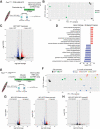This is a preprint.
Lineage tracing of newly accrued nuclei in skeletal myofibers uncovers distinct transcripts and interplay between nuclear populations
- PMID: 37662191
- PMCID: PMC10473681
- DOI: 10.1101/2023.08.24.554609
Lineage tracing of newly accrued nuclei in skeletal myofibers uncovers distinct transcripts and interplay between nuclear populations
Update in
-
Lineage tracing of nuclei in skeletal myofibers uncovers distinct transcripts and interplay between myonuclear populations.Nat Commun. 2024 Oct 30;15(1):9372. doi: 10.1038/s41467-024-53510-z. Nat Commun. 2024. PMID: 39477931 Free PMC article.
Abstract
Multinucleated skeletal muscle cells have an obligatory need to acquire additional nuclei through fusion with activated skeletal muscle stem cells when responding to both developmental and adaptive growth stimuli. A fundamental question in skeletal muscle biology has been the reason underlying this need for new nuclei in syncytial cells that already harbor hundreds of nuclei. To begin to answer this long-standing question, we utilized nuclear RNA-sequencing approaches and developed a lineage tracing strategy capable of defining the transcriptional state of recently fused nuclei and distinguishing this state from that of pre-existing nuclei. Our findings reveal the presence of conserved markers of newly fused nuclei both during development and after a hypertrophic stimulus in the adult. However, newly fused nuclei also exhibit divergent gene expression that is determined by the myogenic environment to which they fuse. Moreover, accrual of new nuclei through fusion is required for nuclei already resident in adult myofibers to mount a normal transcriptional response to a load-inducing stimulus. We propose a model of mutual regulation in the control of skeletal muscle development and adaptations, where newly fused and pre-existing myonuclear populations influence each other to maintain optimal functional growth.
Conflict of interest statement
Declaration of interests The authors declare no competing financial interests.
Figures







References
Publication types
Grants and funding
LinkOut - more resources
Full Text Sources
